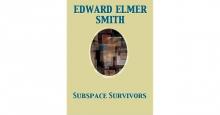- Home
- E. E. Smith
Skylark Three
Skylark Three Read online
Produced by Greg Weeks, LN Yaddanapudi, Flash Sheridan andthe Online Distributed Proofreading Team athttps://www.pgdp.net
Skylark Three
_By_
Edward E. Smith,Ph. D.
Sequel to"The Skylark of Space"
+--------------------------------------------------------------+ | _"All set," he reported crisply, and barked a series of | | explosive syllables at Shiro, ending upon a rising note._ | | | | _The Tale of the Galactic Cruise Which Ushered in Universal | | Civilization_ | +--------------------------------------------------------------+
+--------------------------------------------------------------+ | _For two years readers of_ AMAZING STORIES _have literally | | clamored for a sequel to the famous story, "The Skylark of | | Space," which appeared exactly two years ago. Except that | | "Skylark Three" is more thrilling, more exciting and even | | more chockful of science than the other. Dr. Smith tells | | about the story in his author's note far better than we can | | do._ | | | | Illustrated by WESSO | +--------------------------------------------------------------+
+--------------------------------------------------------------+ | Transcriber's Note | | | | This etext was produced from Amazing Stories August, | | September and October 1930. Extensive research did not | | uncover any evidence that the U.S. copyright on this | | publication was renewed. | | | | Other Transcriber Notes and Errata are given at the end of | | the text. | +--------------------------------------------------------------+
AUTHOR'S NOTE:
To all profound thinkers in the realms of Science who may chance to readSKYLARK THREE, greetings:
I have taken certain liberties with several more or less commonlyaccepted theories, but I assure you that those theories have not beenviolated altogether in ignorance. Some of them I myself believe sound,others I consider unsound, still others are out of my line, so that I amnot well enough informed upon their basic mathematical foundations tohave come to any definite conclusion, one way or the other. Whether ornot I consider any theory sound, I did not hesitate to disregard it, ifits literal application would have interfered with the logicaldevelopment of the story. In "The Skylark of Space" Mrs. Garby and Idecided, after some discussion, to allow two mathematicalimpossibilities to stand. One of these immediately became the target ofcritics from Maine to California and, while no astronomer has as yetcalled attention to the other, I would not be surprised to hear aboutit, even at this late date.
While I do not wish it understood that I regard any of the majorfeatures of this story as likely to become facts in the nearfuture--indeed, it has been my aim to portray the highly improbable--itis my belief that there is no mathematical or scientific impossibilityto be found in "Skylark Three."
In fact, even though I have repeatedly violated theories in which Imyself believe, I have in every case taken great pains to make certainthat the most rigid mathematical analysis of which I am capable hasfailed to show that I have violated any known and proven scientificfact. By "fact" I do not mean the kind of reasoning, based uponassumptions later shown to be fallacious, by which it was "proved" thatthe transatlantic cable and the airplane were scientifically impossible.I refer to definitely known phenomena which no possible futuredevelopment can change--I refer to mathematical proofs whose fundamentalequations and operations involve no assumptions and contain nosecond-degree uncertainties.
Please bear in mind that we KNOW very little. It has been widelybelieved that the velocity of light is the limiting velocity, and manyof our leading authorities hold this view--but it cannot be proved, andis by no means universally held. In this connection, it would appearthat J. J. Thompson, in "Beyond the Electron" shows, to his ownsatisfaction at least, that velocities vastly greater than that of lightare not only possible, but necessary to any comprehensive investigationinto the nature of the electron.
We do not know the nature of light. Neither the undulatory theory northe quantum theory are adequate to explain all observed phenomena, andthey seem to be mutually exclusive, since it would seem clear bydefinition that no one thing can be at the same time continuous anddiscontinuous. We know nothing of the ether--we do not even know whetheror not it exists, save as a concept of our own extremely limitedintelligence. We are in total ignorance of the ultimate structure ofmatter, and of the arrangement and significance of those largeraggregations of matter, the galaxies. We do not know nor understand, norcan we define, even such fundamental necessities as time and space.
Why prate of "the impossible"?
Edward Elmer Smith, Ph.D.

 The Galaxy Primes
The Galaxy Primes Triplanetary
Triplanetary Spacehounds of IPC
Spacehounds of IPC Skylark Three
Skylark Three The Vortex Blaster
The Vortex Blaster Subspace Survivors
Subspace Survivors